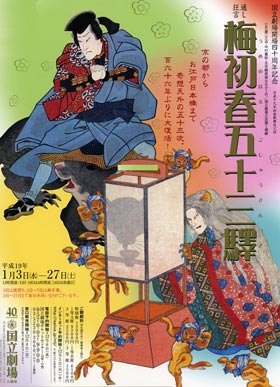| JANUARY 2007 |
|
5 shows in T˘ky˘ (Kabukiza, National Theatre, Asakusa K˘kaid˘), 2 in ďsaka (Sh˘chikuza) and 1 in Ky˘to (Minamiza)!
|
| Kabukiza (T˘ky˘) |  |
| Dates | 2 ~ 26 January 2007 (Kotobuki Hatsuharu ďkabuki) |
| MatinÚe |
Sh˘chikubai |
| Evening | |
| Casting |
Band˘ Tamasabur˘, Nakamura Jakuemon, Matsumoto K˘shir˘, Nakamura Kichiemon, Nakamura Kanzabur˘, Nakamura Tomijűr˘, Nakamura Shikan, Nakamura Shibajaku, Ichikawa Sadanji, Nakamura Hashinosuke, Nakamura Baigyoku, Nakamura Kaishun, Kataoka Takatar˘, Nakamura Fukusuke, Nakamura Shinjir˘, Nakamura Karoku, Nakamura Kash˘, Band˘ Yajűr˘, Nakamura T˘z˘, Ichikawa Komaz˘, Nakamura Matsue |
| Comments |
|
| Sh˘chikuza (ďsaka) |
| Dates | 2 ~ 26 January 2007 (Kotobuki Hatsuharu ďkabuki) |
| MatinÚe | |
| Evening | |
| Casting |
Ichikawa Danjűr˘, Sakata T˘jűr˘, Ichikawa Ebiz˘, Nakamura Kanjaku, Nakamura Senjaku, Kataoka Gat˘, Kataoka Hidetar˘, Kataoka Shinnosuke |
| Comments |
|
| National Theatre (T˘ky˘) |
| Dates | 3 ~ 27 January 2007 (Hatsuharu ďkabuki) |
| Program |
Ume no Haru Gojűsan Tsugi |
| Casting |
Onoe Kikugor˘, Nakamura Tokiz˘, Band˘ Mitsugor˘, Onoe Kikunosuke, Band˘ Hikosabur˘, Onoe Sh˘roku |
| Comments |
Continuing its celebration of its fortieth anniversary, the National Theatre will do the first production of a kabuki play in 166 years, a play full of chills and thrills and wild spectacle. In 1827, when audiences went to see "Hitori Tabi Gojűsan Tsugi" (Traveling Alone to the Fifty-three Stations), by the famous playwright Tsuruya Nanboku IV (1755~1829) they expected a Kabuki version of the bestselling comic novel about the adventures of Yaji and Kita on the road. What they got instead was a spectacular series of scenes scary, sexy and comic reworking all Nanboku's favorite themes including a monstrous cat and changing one of the most famous mother and son couples in Kabuki, keeping the names but changing what they do drastically, transforming them into a pair of adult lovers. The play was a long-running hit and inspired many plays with spectacular scenic effects. In 1835, a group of playwrights including Nanboku's son, Tsuruya Nanboku V reworked this play, keeping the monstrous cat but adding a renegade priest who mastered rat magic and a famous thief named Nezumi Koz˘ ("Kid Rat"). Then they worked old Tsuruya Nanboku's transformative magic on the passionate grocer's daughter Oshichi, making her into Sayoginu Oshichi and bringing the handsome young samurai Shirai Gonpachi and his lover, the courtesan Komurasaki, into the mix as well. The play starred Onoe Kikugor˘ III (1784~1849) and featured the ghosts and stage tricks that he had developed with Tsuruya Nanboku that had made his career. In January 2007 at the National Theatre, Living National Treasure Onoe Kikugor˘ will revive this version of the play for the first time and challenge himself with the spectacular scenes and famous roles from the earliest times of his family's acting tradition. Also starring Living National Treasure Sawamura Tanosuke, Band˘ Hikosabur˘, Nakamura Tokiz˘, Band˘ Mitsugor˘, Onoe Sh˘roku and Onoe Kikunosuke. Source: Earphone Guide website |
 |
|
|
|||
| Dates | 2 ~ 26 January 2007 (Hatsuharu Hanagata Kabuki) | ||
| MatinÚe | |||
| Evening |
|
||
| Casting |
Nakamura Shid˘, Kataoka Ainosuke, Ichikawa Omez˘, Nakamura Kantar˘, Nakamura Shid˘, Nakamura Kikaku |
||
| Comments |
The yearly show for young promising actors at the Asakusa K˘kaid˘ in the heart of Asakusa, a lively and colorful neighboorhood that keeps the scent of old Edo. |
||
|
|||
| Dates | 3 ~ 25 January 2007 (Zenshinza K˘en) | ||
| Program |
Gojű no T˘ |
||
| Casting |
Nakamura Umenosuke, Kawarasaki Kunitar˘, Arashi Keishi, Nakamura Baijaku, Fujikawa Yanosuke, Segawa Kikunoj˘, Arashi Hiroya |
||
| Comments |
|
||
|
|
| Contact | Main | Top | Updates | Actors | Plays | Playwrights | Programs | Links | FAQ | Glossary | Chronology | Illustrations | Prints | Characters | Derivatives | Theaters | Coming soon | News |